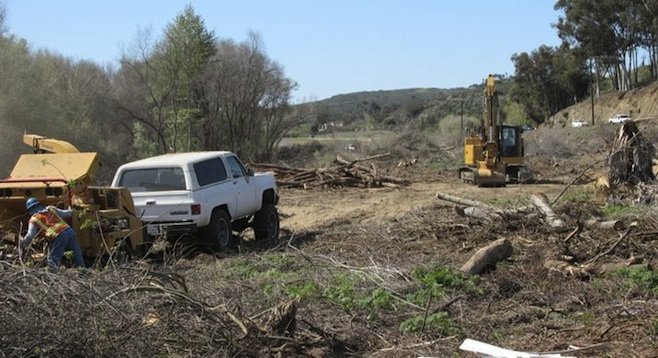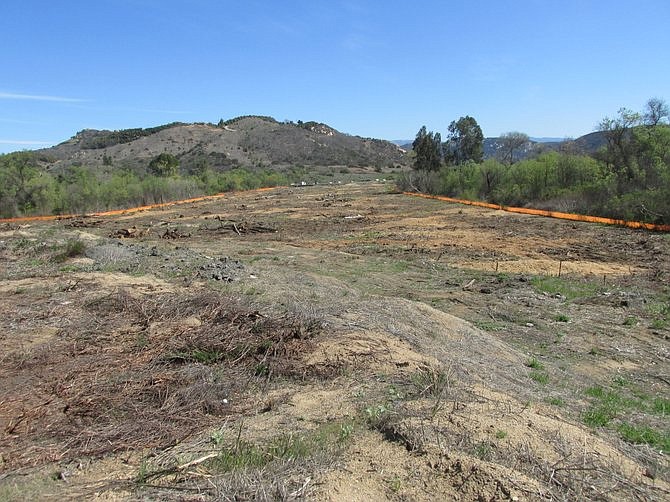 Facebook
Facebook
 X
X
 Instagram
Instagram
 TikTok
TikTok
 Youtube
Youtube

Motorists along Highway 76 between Bonsall and I-15 are happy to see that the final six-mile phase of the Highway 76 widening project has begun. Last week, crews started clearing out heavy brush and trees from the overgrown San Luis Rey River flood plain.

As of March 12, three crews have only 1.7 miles remaining to be cleared along the route that stretches east from South Mission Road to the I-15/Highway 76 interchange.
The project, expected to be completed in three years, will turn the two-lane curvy road into a four-lane divided highway. Currently, 20,000 cars travel the road daily. Often on weekends, with those heading toward the beach, or on a Friday afternoon with those trying to get home to Temecula or to the three casinos in the area, this section of Highway 76 becomes a slow-moving parking lot.
In preparation for grading, up to 200 feet of brush needed to be cleared. In other areas, a new road alignment can be seen cleared; an effort to reduce curves. Brush is being shredded on site, with the cut up tree logs being taken to a spot on the upper northwest corner of the Highway 76/I-15 Park N Ride lot, where a sign reads, “FREE FIREWOOD.”
Transnet, the transportation arm of San Diego County Association of Governments, which coordinates projects on behalf of Caltrans, is funding the project. Voters approved a half-cent sales tax in 1988, with Highway 76’s widening one of the main projects proposed. The road-widening never happened.
In 2004, when SANDAG wanted voters to reaffirm the sales tax for another 40 years, transportation officials had to heavily campaign North County voters who were skeptical from being promised an improved Highway 76 then passed over for other projects.
The countywide 2004 ballot measure was approved by a slim margin. The campaign focused on major freeway-widening projects such as the 76, I-15, SR-56, SR-52, and SR-905. Most voters probably didn’t know that the regional highway tax would also be used for buses, trains, bike lanes, adding of HOV lanes, sidewalks, and local cities’ road and bridge improvements.
While daily commuters appreciate any improvements, longtime residents point out that in the 1970s, Highway 76 was supposed to be developed into a four-lane freeway from I-5 to I-15. Only a short, one-mile, freeway-type bypass was completed, to avoid Oceanside’s heavily traveled El Camino Real/Mission Road intersection.
The portion of Highway 76’s widening from Oceanside’s College Drive to Bonsall’s South Mission Road was completed over the past decade, with the latest section, a four-lane divided highway from East Vista Way to Bonsall, opening up in 2013.
With continued growth in southwestern Riverside County, the addition of a large satellite campus of Palomar College, 800 new homes across the I-15 freeway, and the increasing growth of nearby casinos, Caltrans projects daily traffic volume along Highway 76 will reach 46,000 vehicles by 2030.


Motorists along Highway 76 between Bonsall and I-15 are happy to see that the final six-mile phase of the Highway 76 widening project has begun. Last week, crews started clearing out heavy brush and trees from the overgrown San Luis Rey River flood plain.

As of March 12, three crews have only 1.7 miles remaining to be cleared along the route that stretches east from South Mission Road to the I-15/Highway 76 interchange.
The project, expected to be completed in three years, will turn the two-lane curvy road into a four-lane divided highway. Currently, 20,000 cars travel the road daily. Often on weekends, with those heading toward the beach, or on a Friday afternoon with those trying to get home to Temecula or to the three casinos in the area, this section of Highway 76 becomes a slow-moving parking lot.
In preparation for grading, up to 200 feet of brush needed to be cleared. In other areas, a new road alignment can be seen cleared; an effort to reduce curves. Brush is being shredded on site, with the cut up tree logs being taken to a spot on the upper northwest corner of the Highway 76/I-15 Park N Ride lot, where a sign reads, “FREE FIREWOOD.”
Transnet, the transportation arm of San Diego County Association of Governments, which coordinates projects on behalf of Caltrans, is funding the project. Voters approved a half-cent sales tax in 1988, with Highway 76’s widening one of the main projects proposed. The road-widening never happened.
In 2004, when SANDAG wanted voters to reaffirm the sales tax for another 40 years, transportation officials had to heavily campaign North County voters who were skeptical from being promised an improved Highway 76 then passed over for other projects.
The countywide 2004 ballot measure was approved by a slim margin. The campaign focused on major freeway-widening projects such as the 76, I-15, SR-56, SR-52, and SR-905. Most voters probably didn’t know that the regional highway tax would also be used for buses, trains, bike lanes, adding of HOV lanes, sidewalks, and local cities’ road and bridge improvements.
While daily commuters appreciate any improvements, longtime residents point out that in the 1970s, Highway 76 was supposed to be developed into a four-lane freeway from I-5 to I-15. Only a short, one-mile, freeway-type bypass was completed, to avoid Oceanside’s heavily traveled El Camino Real/Mission Road intersection.
The portion of Highway 76’s widening from Oceanside’s College Drive to Bonsall’s South Mission Road was completed over the past decade, with the latest section, a four-lane divided highway from East Vista Way to Bonsall, opening up in 2013.
With continued growth in southwestern Riverside County, the addition of a large satellite campus of Palomar College, 800 new homes across the I-15 freeway, and the increasing growth of nearby casinos, Caltrans projects daily traffic volume along Highway 76 will reach 46,000 vehicles by 2030.
Comments